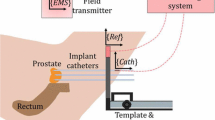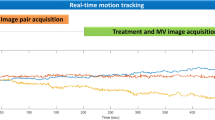Abstract
Purpose
To evaluate a novel navigation system for breast brachytherapy, based on ultrasound (US)-guided catheter needle implantations followed by electromagnetic (EM) tracking of catheter paths.
Methods
Breast phantoms were produced, containing US–visible tumors. Ultrasound was used to localize the tumor pose and volume within the phantom, followed by planning an optimal catheter pattern through the tumor using navigation software. An electromagnetic (EM)-tracked catheter needle was used to insert the catheters in the desired pattern. The inserted catheters were visualized on a post-implant CT, serving as ground truth. Electromagnetic (EM) tracking and reconstruction of the inserted catheter paths were performed by pulling a flexible EM guidewire through each catheter, performed in two clinical brachytherapy suites. The accuracy of EM catheter tracking was evaluated by calculating the Hausdorff distance between the EM-tracked and CT-based catheter paths. The accuracy and clinical feasibility of EM catheter tracking were also evaluated in three breast cancer patients, performed in a separate experiment room.
Results
A total of 71 catheter needles were implanted into 12 phantoms using US guidance and EM navigation, in an average ± SD time of 8.1 ± 2.9 min. The accuracy of EM catheter tracking was dependent on the brachytherapy suite: 2.0 ± 1.2 mm in suite 1 and 0.6 ± 0.2 mm in suite 2. EM catheter tracking was successfully performed in three breast brachytherapy patients. Catheter tracking typically took less than 5 min and had an average accuracy of 1.7 ± 0.3 mm.
Conclusion
Our preliminary results show a potential role for US guidance and EM needle navigation for implantation of catheters for breast brachytherapy. EM catheter tracking can accurately assess the implant geometry in breast brachytherapy patients. This methodology has the potential to evaluate catheter positions directly after the implantation and during the several fractions of the treatment.



Similar content being viewed by others
References
Canadian Cancer Statistics Advisory Committee (2019) Canadian cancer statistics 2019. Canadian Cancer Society, Toronto
Khan AJ, Kirk MC, Mehta PS, Seif NS, Griem KL, Bernard DA, Chu JCH, Dickler A (2006) A dosimetric comparison of three-dimensional conformal, intensity-modulated radiation therapy, and MammoSite partial-breast irradiation. Brachytherapy 5:183–188. https://doi.org/10.1016/j.brachy.2006.06.001
Weed DW, Edmundson GK, Vicini FA, Chen PY, Martinez AA (2005) Accelerated partial breast irradiation: a dosimetric comparison of three different techniques. Brachytherapy 4:121–129. https://doi.org/10.1016/j.brachy.2004.12.005
Patel RR, Becker SJ, Das RK, Mackie TR (2007) A dosimetric comparison of accelerated partial breast irradiation techniques: multicatheter interstitial brachytherapy, three-dimensional conformal radiotherapy, and supine versus prone helical tomotherapy. Int J Radiat Oncol Biol Phys 68:935–942. https://doi.org/10.1016/j.ijrobp.2007.03.005
Tsalpatouros A, Baltas D, Kolotas C, van der Laarse R, Koutsouris D, Uzunoglu NK, Zamboglou N (1997) CT-based software for 3-D localization and reconstruction in stepping source brachytherapy. IEEE Trans Inf Technol Biomed 1:229–242. https://doi.org/10.1109/4233.681165
Zhou J, Sebastian E, Mangona V, Yan D (2013) Real-time catheter tracking for high-dose-rate prostate brachytherapy using an electromagnetic 3D-guidance device: a preliminary performance study. Med Phys. https://doi.org/10.1118/1.4788641
Bharat S, Kung C, Dehghan E, Ravi A, Venugopal N, Bonillas A, Stanton D, Kruecker J (2014) Electromagnetic tracking for catheter reconstruction in ultrasound-guided high-dose-rate brachytherapy of the prostate. Brachytherapy 13:640–650. https://doi.org/10.1016/j.brachy.2014.05.012
Bax J, Smith D, Bartha L, Montreuil J, Sherebrin S, Gardi L, Edirisinghe C, Fenster A (2018) A compact mechatronic system for 3D ultrasound guided prostate interventions. Med Phys 38:1055–1069. https://doi.org/10.1118/1.3531540
Ungi T, Gauvin G, Lasso A, Yeo CT, Pezeshki P, Vaughan T, Carter K, Rudan J, Engel CJ, Fichtinger G (2016) Navigated breast tumor excision using electromagnetically tracked ultrasound and surgical instruments. IEEE Trans Biomed Eng 63:600–606. https://doi.org/10.1109/TBME.2015.2466591
Tokuda J, Fischer GS, Papademetris X, Yaniv Z, Ibanez L, Cheng P, Liu H, Blevins J, Arata J, Golby AJ, Kapur T, Pieper S, Burdette EC, Fichtinger G, Tempany CM, Hata N (2009) OpenIGTLink: an open network protocol for image-guided therapy environment. Int J Med Robot Comput Assist Surg 5:423–434. https://doi.org/10.1002/rcs.274
Lasso A, Heffter T, Rankin A, Pinter C, Ungi T, Fichtinger G (2014) PLUS: open-source toolkit for ultrasound-guided intervention systems. IEEE Trans Biomed Eng 61:2527–2537. https://doi.org/10.1109/TBME.2014.2322864
Fedorov A, Beichel R, Kalpathy-Cramer J, Finet J, Fillion-Robin J-C, Pujol S, Bauer C, Jennings D, Fennessy F, Sonka M, Buatti J, Aylward S, Miller JV, Pieper S, Kikinis R (2012) 3D Slicer as an image computing platform for the Quantitative Imaging Network. Magn Reson Imaging 30:1323–1341. https://doi.org/10.1016/j.mri.2012.05.001
Marinello G (2009) Paris system for interstitial brachytherapy. In: Lemoigne Y, Caner A (eds) Radiotherapy and brachytherapy. Springer, Heidelberg, pp 219–225
Vaughan T, Brastianos H, Ungi T, Lasso A, Falkson C, Fichtinger G (2019) Needle navigation and catheter reconstruction for breast brachytherapy using open source software. Acta Polytech Hungarica 16:99–118
Smith BD, Arthur DW, Buchholz TA, Haffty BG, Hahn CA, Hardenbergh PH, Julian TB, Marks LB, Todor DA, Vicini FA, Whelan TJ, White J, Wo JY, Harris JR (2009) Accelerated partial breast irradiation consensus statement from the American Society for Radiation Oncology (ASTRO). Int J Radiat Oncol Biol Phys 74:987–1001. https://doi.org/10.1016/j.ijrobp.2009.02.031
Correa C, Harris EE, Leonardi MC, Smith BD, Taghian AG, Thompson AM, White J, Harris JR (2017) Accelerated partial breast irradiation: executive summary for the update of an ASTRO evidence-based consensus statement. Pract Radiat Oncol 7:73–79. https://doi.org/10.1016/j.prro.2016.09.007
Kåsine T, Romundstad L, Rosseland LA, Ullensvang K, Fagerland MW, Hol PK, Kessler P, Sauter AR (2019) Needle tip tracking for ultrasound-guided peripheral nerve block procedures—an observer blinded, randomised, controlled, crossover study on a phantom model. Acta Anaesthesiol Scand 63:1055–1062. https://doi.org/10.1111/aas.13379
Kellermeier M, Herbolzheimer J, Kreppner S, Lotter M, Strnad V, Bert C (2017) Electromagnetic tracking (EMT) technology for improved treatment quality assurance in interstitial brachytherapy. J Appl Clin Med Phys 18:211–222. https://doi.org/10.1002/acm2.12021
Kellermeier M, Fietkau R, Strnad V, Bert C (2018) Assessment of the implant geometry in fractionated interstitial HDR breast brachytherapy using an electromagnetic tracking system. Brachytherapy 17:94–102. https://doi.org/10.1016/j.brachy.2017.10.007
Funding
Gabor Fichtinger is supported as a Canada Research Chair in Computer-Integrated Surgery. This work was funded, in part, by NIH/NIBIB and NIH/NIGMS (via Grant 1R01EB021396-01A1-Slicer + PLUS: Point-of-Care Ultrasound) and by CANARIE’s Research Software Program.
Author information
Authors and Affiliations
Corresponding author
Ethics declarations
Conflict of interest
The authors declare that they have no conflict of interest.
Additional information
Publisher's Note
Springer Nature remains neutral with regard to jurisdictional claims in published maps and institutional affiliations.
Rights and permissions
About this article
Cite this article
Janssen, N.N.Y., Brastianos, H., Akingbade, A. et al. Electromagnetic (EM) catheter path tracking in ultrasound-guided brachytherapy of the breast. Int J CARS 15, 1645–1652 (2020). https://doi.org/10.1007/s11548-020-02233-9
Received:
Accepted:
Published:
Issue Date:
DOI: https://doi.org/10.1007/s11548-020-02233-9




